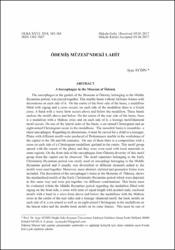| dc.contributor.author | Aydın, Ayşe | |
| dc.date.accessioned | 2020-11-20T16:46:00Z | |
| dc.date.available | 2020-11-20T16:46:00Z | |
| dc.date.issued | 2018 | |
| dc.identifier.issn | 1301-7667 | |
| dc.identifier.uri | https://hdl.handle.net/20.500.12809/5582 | |
| dc.description.abstract | The sarcophagus in the garden of the Museum at Ödemiş, belonging to the Middle Byzantine period, was pieced together. This marble basin without lid bears frames with decorations on each side of it. On the centre of the front side of the basin, a medallion filled with zigzag and a cross occurs; on each side of the medallion there is a Greek cross. A band with a wave form occurs above and below the medallion. These bands enclose the motifs above and below. On the centre of the rear side of the basin, there is a medallion with a Maltese cross and on each side of it, a lozenge motif/diamond motif occurs. On one of the lateral sides of the basin, a six-armed Christogram and an eight-armed Christogram occur in the medallions. The monolith basin is resembles a chest sarcophagus. Regarding its dimensions, it must be carved for a child or a teenager. Plates with different motifs were produced of Prokonnesos marble in the workshops of the capital in the 5th and 6th centuries. On one of them there is a composition with a cross on each side of a Christogram medallion/garland in the centre. This motif group spread with the export of the plates and they were even used with local materials in some regions. On the front side of the sarcophagus from Ödemiş diversity of this motif group from the capital can be observed. The motif repertoire belonging to the Early Christianity-Byzantine period was rarely used on sarcophagi belonging to the Middle Byzantine period and it usually was diversified or different elements added to the motifs were used together. Moreover, more abstract, stylized and geometric forms were included. The decoration of the sarcophagus's basin in the Museum of Ödemiş, shows the standardised motifs of the Early Christianity-Byzantine period which were depicted in this same way and were put together via different combinations. This basin must be evaluated within the Middle Byzantine period regarding the medallion filled with zigzag on the front side, a cross with arms of equal length with pointed ends, enclosed motifs with a band in a wave form above and below, the medallions with the Maltese cross in the centre of the rear sides and a lozenge/diamond motif, the hook motifs on each side of it, a six-armed as well as an eight-armed Christogram in the medallions on the lateral sides and the double hook motifs on its outer frames. This must be one of the most important sarcophagi in Anatolia reflecting the characteristics of the Middle Byzantine period. © 2018 Mersin University. All rights reserved. | en_US |
| dc.description.abstract | Ödemiş Müzesi bahçesinde kırık parçaları bir araya getirilen Orta Bizans dönemine ait bir lahit teknesi vardır. Mermerden kapaksız teknenin düz, sade çerçeve içine alınan dört yüzü de süslemelidir. Lahit teknesinin ön yüzünün merkezinde içinde haç olan zikzak dolgulu bir madalyon ve iki yanında birer Yunan haçı yer alır. Madalyonun altından ve üstünden iki yana dalga formlu birer şerit çıkar. Şeritler motifleri alttan ve üstten sınırlar. Teknenin arka yüzünün merkezinde içinde Malta haçı olan madalyon ve iki yanında birer eşkenar dörtgen/baklava motifi yer alır. Teknenin yan yüzlerinden birinde madalyon içinde altı, diğerinde sekiz kollu Kristogram vardır. Monolit lahit teknesi Sandık lahit tipindedir. Tekne, ölçüleri açısından değerlendirildiğinde bir çocuk ya da ergen için yapılmış olmalıdır. 5.-6.yüzyıllarda başkent atölyelerinde Prokonnesos mermerinden farklı motiflere sahip levhalar üretilmiştir. Bunlardan biri de merkezde Kristogramlı madalyon/çelengin iki yanındaki haçtan oluşan kompozisyondur. Bu motif grubu levhaların ihraç edilmesiyle her yere dağılmış, hatta bazı bölgelerde yerel
malzemeye de uygulanmıştır. Ödemişli lahit teknesinin ön yüzünde de başkentli bu motif grubunun bir çeşitlemesi söz konusudur. Orta Bizans dönemi lahitlerinde Erken Hıristiyanlık-Bizans dönemi motif repertuvarı nadiren aynen uygulanmış, genellikle farklılaştırılmış veya bu motiflere farklı unsurlar katılarak beraber kullanılmış; daha çok
soyut, stilize ve geometrik biçimlere yer verilmiştir. Ödemiş Müzesi’ndeki lahit teknesinin süsleme programında da Erken Hıristiyanlık-Bizans döneminde standartlaşan
motifler birebir uygulanmamıştır. Bilinen motifler farklı kombinasyonlarla bir araya getirilmiştir. Ön yüzdeki içi zikzak dolgulu madalyon, madalyonun içinde uçları
sivri biten eşit kolları olan haç, motiflerin alttan ve üstten dalga formlu birer şeritle sınırlanması, arka yüz merkezindeki Malta haçlı madalyon ile iki yanındaki eşkenar dörtgen/baklava ve çengel motifleri, yan yüzlerdeki madalyon içinde altı ve sekiz kollu Kristogramlarla dış çerçevelerindeki çift çengel motifleri Ödemişli lahit teknesinin de Orta Bizans dönemi içinde değerlendirilmesini gerektirir. Ödemiş Müzesi’ndeki lahit
teknesi, Anadolu’daki sayılı Orta Bizans dönemine tarihlenebilecek dönem özelliklerini yansıtan lahitlerden biridir. | |
| dc.item-language.iso | tur | en_US |
| dc.publisher | Mersin University | en_US |
| dc.item-rights | info:eu-repo/semantics/openAccess | en_US |
| dc.subject | Child's sarcaphagus | en_US |
| dc.subject | Christogram | en_US |
| dc.subject | Cross | en_US |
| dc.subject | Middle Byzantine | en_US |
| dc.subject | Ödemiş | en_US |
| dc.title | Ödemiş Müzesi'ndeki Lahit | en_US |
| dc.item-title.alternative | A sarcophagus in the museum of Ödemiş | en_US |
| dc.item-type | article | en_US |
| dc.contributor.department | MÜ, Edebiyat Fakültesi, Sanat Tarihi Bölümü | en_US |
| dc.contributor.institutionauthor | Aydın, Ayşe | |
| dc.identifier.volume | 26 | en_US |
| dc.identifier.startpage | 345 | en_US |
| dc.identifier.endpage | 368 | en_US |
| dc.relation.journal | Olba | en_US |
| dc.relation.publicationcategory | Makale - Uluslararası Hakemli Dergi - Kurum Öğretim Elemanı | en_US |


















